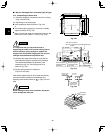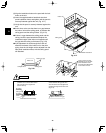
43
A
Fig. 3-64
Air bleed valve
Fig. 3-66
Fig. 3-65
0 – 45°
11-13/16 in. or less
33-15/32 in. or less
* Length of supplied drain hose = 9-27/32 in.
Uphill slope
Fig. 3-67
Support
bracket
CAUTION
3-17. Checking the Drainage
After wiring and drain piping are completed, use the
following procedure to check that the water will drain
smoothly. For this, prepare a bucket and wiping cloth to
catch and wipe up spilled water.
(1) Connect power to the power terminal board (R, S
terminals) inside the electrical component box.
(2) Slowly pour approx. 0.2 gal of water into the drain pan
using a siphon pump through the air outlet grille. (Fig.
3-68)
(3) Short the check pin (CHK) on the indoor control board
and operate the drain pump. Check the water flow
through the transparent drain pipe and see if there is any
leakage.
(4) When the drainage check is complete, open the check
pin (CHK) and remount the insulator.
CAUTION
CAUTION
Be careful since the fan will start
when you short the pin on the indoor
control board.
The bottom drain port is for use
only during test runs and servicing
inspections. Do not connect the drain
pipe to the bottom drain port.
water (approx. 0.2 gal)
Drainage check
Drain tube
connection
(transparent)
Discharge port
Fig. 3-68
●
Do not install an air bleeder as this may cause water
to spray from the drain pipe outlet. (Fig. 3-64)
●
In cases where it is necessary to raise the height of
the drain piping, the drain piping can be raised to a
maximum height of 33-15/32" above the bottom
surface of the ceiling. Under no conditions attempt to
raise it higher than 33-15/32" above the bottom
surface of the ceiling. Doing so will result in water
leakage. (Fig. 3-65)
●
Do not use natural drainage.
●
Do not install the pipe with an upward gradient from
the connection port. This will cause the drain water
to flow backward and leak when the unit is not
operating. (Fig. 3-66)
●
Do not apply force to the piping on the unit side when
connecting the drain pipe. The pipe should not be
allowed to hang unsupported from its connection to
the unit. Fasten the pipe to a wall, frame, or other sup-
port as close to the unit as possible. (Fig. 3-67)
●
Provide insulation for any pipes that are run indoors.


















